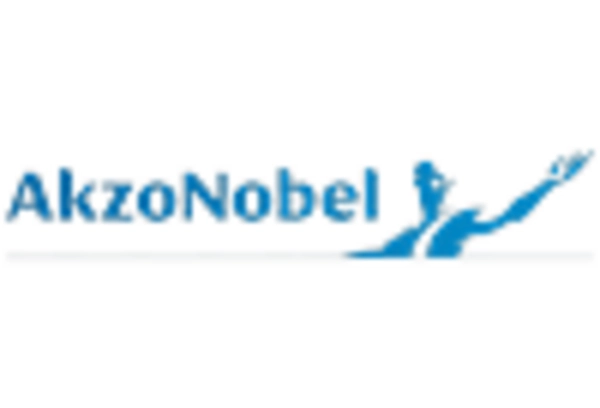Growth in the Automotive Sector
The North America Textile Coatings Market is significantly influenced by the growth of the automotive sector, which increasingly utilizes coated textiles for interior and exterior applications. The demand for lightweight, durable, and aesthetically pleasing materials is driving manufacturers to invest in advanced textile coatings. Recent statistics indicate that the automotive textiles market is expected to reach USD 30 billion by 2026, with a substantial portion attributed to coated fabrics. This growth is likely to spur innovation in textile coatings, as companies strive to meet the evolving needs of automotive manufacturers and consumers alike.
Increased Focus on Sustainability
Sustainability has emerged as a critical driver in the North America Textile Coatings Market, as both consumers and manufacturers prioritize eco-friendly practices. The shift towards sustainable materials is prompting companies to develop coatings that are non-toxic and biodegradable. Recent surveys suggest that over 60% of consumers are willing to pay a premium for sustainable products, which is influencing manufacturers to adapt their offerings accordingly. This trend not only aligns with regulatory pressures but also enhances brand reputation, making sustainability a pivotal factor in the growth of the textile coatings market.
Rising Demand for Functional Textiles
The North America Textile Coatings Market is experiencing a notable increase in demand for functional textiles, which are designed to provide specific benefits such as water resistance, UV protection, and flame retardancy. This trend is driven by various sectors, including automotive, healthcare, and sportswear, where performance and safety are paramount. According to recent data, the functional textiles segment is projected to grow at a compound annual growth rate of approximately 5.2% over the next five years. As consumers become more aware of the advantages of coated textiles, manufacturers are compelled to innovate and expand their product offerings, thereby enhancing the overall market landscape.
Customization Trends in Consumer Preferences
The North America Textile Coatings Market is witnessing a shift towards customization, as consumers increasingly seek personalized products that reflect their individual tastes and preferences. This trend is particularly evident in sectors such as fashion and home textiles, where unique designs and functionalities are in high demand. Manufacturers are responding by offering tailored coating solutions that cater to specific customer requirements. Market analysis suggests that the customization segment could account for a significant share of the textile coatings market, potentially reaching USD 5 billion by 2027, as brands strive to differentiate themselves in a competitive landscape.
Technological Innovations in Coating Processes
Technological advancements are reshaping the North America Textile Coatings Market, with innovations in coating processes leading to improved performance and efficiency. Techniques such as digital printing and nanotechnology are enabling manufacturers to create high-performance coatings that offer enhanced durability and functionality. The integration of smart textiles, which can respond to environmental stimuli, is also gaining traction. As these technologies evolve, they are expected to drive market growth, with projections indicating a potential increase in market size by 7% annually over the next few years.

















Leave a Comment